Related Research Articles
Experimental cancer treatments are mainstream medical therapies intended to treat cancer by improving on, supplementing or replacing conventional methods. However, researchers are still trying to determine whether these treatments are safe and effective treatments. Experimental cancer treatments are normally available only to people who participate in formal research programs, which are called clinical trials. Occasionally, a seriously ill person may be able to access an experimental drug through an expanded access program. Some of the treatments have regulatory approval for treating other conditions. Health insurance and publicly funded health care programs normally refuse to pay for experimental cancer treatments.
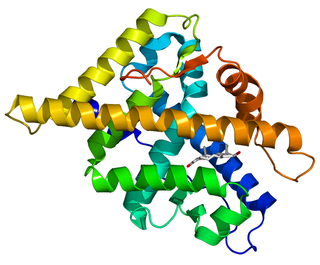
The androgen receptor (AR), also known as NR3C4, is a type of nuclear receptor that is activated by binding any of the androgenic hormones, including testosterone and dihydrotestosterone, in the cytoplasm and then translocating into the nucleus. The androgen receptor is most closely related to the progesterone receptor, and progestins in higher dosages can block the androgen receptor.
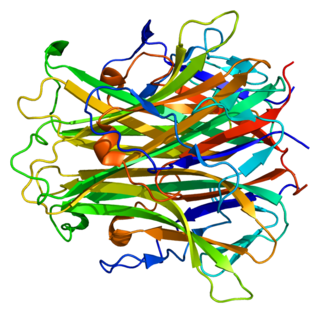
Receptor activator of nuclear factor kappa-Β ligand (RANKL), also known as tumor necrosis factor ligand superfamily member 11 (TNFSF11), TNF-related activation-induced cytokine (TRANCE), osteoprotegerin ligand (OPGL), and osteoclast differentiation factor (ODF), is a protein that in humans is encoded by the TNFSF11 gene.
Demethylases are enzymes that remove methyl (CH3) groups from nucleic acids, proteins (particularly histones), and other molecules. Demethylases are important epigenetic proteins, as they are responsible for transcriptional regulation of the genome by controlling the methylation of DNA and histones, and by extension, the chromatin state at specific gene loci.

Cysteine-rich angiogenic inducer 61 (CYR61) or CCN family member 1 (CCN1), is a matricellular protein that in humans is encoded by the CYR61 gene.

Transforming growth factor beta-1-induced transcript 1 protein is a protein that in humans is encoded by the TGFB1I1 gene. Often put together with and studied alongside TGFB1I1 is the mouse homologue HIC-5. As the name suggests, TGFB1I1 is an induced form of the larger family of TGFB1. Studies suggest TGFB1I1 plays a role in processes of cell growth, proliferation, migration, differentiation and senescence. TGFB1I1 is most localized at focal adhesion complexes of cells, although it may be found active in the cytosol, nucleus and cell membrane as well.
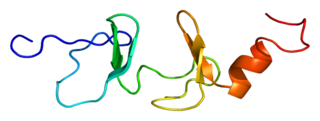
Four and a half LIM domains protein 2 also known as FHL-2 is a protein that in humans is encoded by the FHL2 gene. LIM proteins contain a highly conserved double zinc finger motif called the LIM domain.

Homeobox protein Nkx-3.1, also known as NKX3-1, NKX3, BAPX2, NKX3A and NKX3.1 is a protein that in humans is encoded by the NKX3-1 gene located on chromosome 8p. NKX3-1 is a prostatic tumor suppressor gene.

Growth arrest and DNA-damage-inducible protein GADD45 gamma is a protein that in humans is encoded by the GADD45G gene on chromosome 9. GADD45G is also known as CR6, DDIT2, GRP17, OIG37, and GADD45gamma. GADD45G is involved in several different processes, including sexual development, human-specific brain development, tumor suppression, and the cellular stress response. GADD45G interacts with several other proteins that are involved in DNA repair, cell cycle control, apoptosis, and senescence. Low expression of GADD45G has been associated with many types of cancer.

Anterior gradient protein 2 homolog (AGR-2), also known as secreted cement gland protein XAG-2 homolog, is a protein that in humans is encoded by the AGR2 gene. Anterior gradient homolog 2 was originally discovered in Xenopus laevis. In Xenopus AGR2 plays a role in cement gland differentiation, but in human cancer cell lines high levels of AGR2 correlate with downregulation of the p53 response, cell migration, and cell transformation. However, there have been other observations that AGR2 can repress growth and proliferation.

Prostasin is a protein that in humans is encoded by the PRSS8 gene.
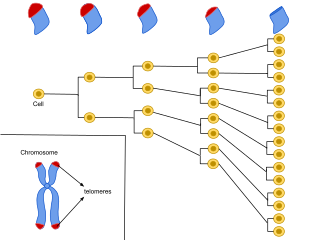
Cellular senescence is a phenomenon characterized by the cessation of cell division. In their experiments during the early 1960s, Leonard Hayflick and Paul Moorhead found that normal human fetal fibroblasts in culture reach a maximum of approximately 50 cell population doublings before becoming senescent. This process is known as "replicative senescence", or the Hayflick limit. Hayflick's discovery of mortal cells paved the path for the discovery and understanding of cellular aging molecular pathways. Cellular senescence can be initiated by a wide variety of stress inducing factors. These stress factors include both environmental and internal damaging events, abnormal cellular growth, oxidative stress, autophagy factors, among many other things.
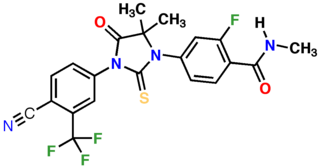
Enzalutamide, sold under the brand name Xtandi, is a nonsteroidal antiandrogen (NSAA) medication which is used in the treatment of prostate cancer. It is indicated for use in conjunction with castration in the treatment of metastatic castration-resistant prostate cancer (mCRPC), nonmetastatic castration-resistant prostate cancer, and metastatic castration-sensitive prostate cancer (mCSPC). It is taken by mouth.
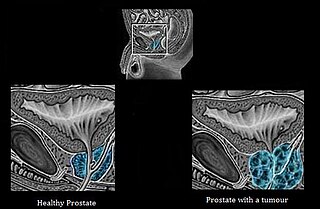
Androgen deprivation therapy (ADT), also called androgen ablation therapy or androgen suppression therapy, is an antihormone therapy whose main use is in treating prostate cancer. Prostate cancer cells usually require androgen hormones, such as testosterone, to grow. ADT reduces the levels of androgen hormones, with drugs or surgery, to prevent the prostate cancer cells from growing. The pharmaceutical approaches include antiandrogens and chemical castration.

Apalutamide, sold under the brand name Erleada among others, is a nonsteroidal antiandrogen (NSAA) medication which is used in the treatment of prostate cancer. It is specifically indicated for use in conjunction with castration in the treatment of non-metastatic castration-resistant prostate cancer (NM-CRPC). It is taken by mouth.
Senotherapy is an early-stage basic research field for development of possible therapeutic agents and strategies to specifically target cellular senescence, an altered cell state associated with ageing and age-related diseases. The name derives from intent of the proposed anti-aging drug to halt "senescence". As of 2019, much of the research remains preliminary and there are no drugs approved for this purpose.

Zinc transporter ZIP9, also known as Zrt- and Irt-like protein 9 (ZIP9) and solute carrier family 39 member 9, is a protein that in humans is encoded by the SLC39A9 gene. This protein is the 9th member out of 14 ZIP family proteins, which is a membrane androgen receptor (mAR) coupled to G proteins, and also classified as a zinc transporter protein. ZIP family proteins transport zinc metal from the extracellular environment into cells through cell membrane.
The side effects of bicalutamide, a nonsteroidal antiandrogen (NSAA), including its frequent and rare side effects, have been well-studied and characterized. The most common side effects of bicalutamide monotherapy in men include breast tenderness, breast growth, feminization, demasculinization, and hot flashes. Less common side effects of bicalutamide monotherapy in men include sexual dysfunction, depression, fatigue, weakness, and anemia. Bicalutamide is well tolerated and has few side effects in women. General side effects of bicalutamide that may occur in either sex include diarrhea, constipation, abdominal pain, nausea, dry skin, itching, and rash.
Senescence-associated secretory phenotype (SASP) is a phenotype associated with senescent cells wherein those cells secrete high levels of inflammatory cytokines, immune modulators, growth factors, and proteases. SASP may also consist of exosomes and ectosomes containing enzymes, microRNA, DNA fragments, chemokines, and other bioactive factors. Soluble urokinase plasminogen activator surface receptor is part of SASP, and has been used to identify senescent cells for senolytic therapy. Initially, SASP is immunosuppressive and profibrotic, but progresses to become proinflammatory and fibrolytic. SASP is the primary cause of the detrimental effects of senescent cells.
Dr. Khalid Zaffar Masoodi was born at Narwara near Iddgah in Srinagar, J&K, India in April 1979. His father was a renowned doctor and educator.
References
- ↑ Pernicová, Z; Slabáková, E; Kharaishvili, G; Bouchal, J; Král, M; Kunická, Z; Machala, M; Kozubík, A; Souček, K (June 2011). "Androgen depletion induces senescence in prostate cancer cells through down-regulation of Skp2". Neoplasia. 13 (6): 526–36. doi:10.1593/neo.11182. PMC 3114246 . PMID 21677876.
- ↑ Ewald, JA; Desotelle, JA; Church, DR; Yang, B; Huang, W; Laurila, TA; Jarrard, DF (March 2013). "Androgen deprivation induces senescence characteristics in prostate cancer cells in vitro and in vivo". The Prostate. 73 (4): 337–45. doi:10.1002/pros.22571. PMC 4753826 . PMID 22911222.
- ↑ Burton, Dominick G. A.; Giribaldi, Maria G.; Munoz, Anisleidys; Halvorsen, Katherine; Patel, Asmita; Jorda, Merce; Perez-Stable, Carlos; Rai, Priyamvada; Agoulnik, Irina U. (27 June 2013). Agoulnik, Irina U (ed.). "Androgen Deprivation-Induced Senescence Promotes Outgrowth of Androgen-Refractory Prostate Cancer Cells". PLOS ONE. 8 (6): e68003. Bibcode:2013PLoSO...868003B. doi: 10.1371/journal.pone.0068003 . PMC 3695935 . PMID 23840802.
- ↑ Barakat et al (2015). CCAAT/Enhancer binding protein β controls androgen-deprivation-induced senescence in prostate cancer cells Oncogene {{doi:10.1038/onc.2015.41}}
- ↑ Kawata, Hirotoshi; Kamiakito, Tomoko; Nakaya, Takeo; Komatsubara, Maiko; Komatsu, Kenji; Morita, Tatsuo; Nagao, Yasumitsu; Tanaka, Akira (2017). "Stimulation of cellular senescent processes, including secretory phenotypes and anti-oxidant responses, after androgen deprivation therapy in human prostate cancer". The Journal of Steroid Biochemistry and Molecular Biology. 165 (Pt B): 219–227. doi:10.1016/j.jsbmb.2016.06.007. PMID 27329245. S2CID 6273648.